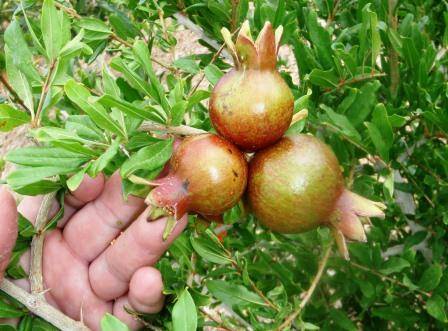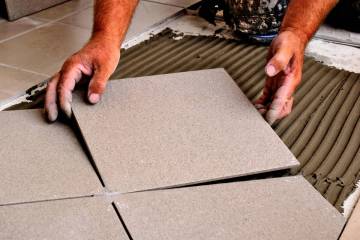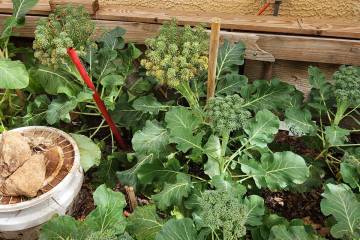Wait until spring to prune pomegranate trees
Q: What should I do to increase the size of my pomegranate fruit next year? My soil has a red color.
A: Red soil tells me you are probably not from around here and, secondly, your soil has a lot of iron in it. This type of iron is not available to most plants because it is low in organics and the acidity is wrong. In severe cases, new leaves may become yellow.
I also assume you are a backyard producer and not a farmer. My recommendations might be different if you had 50 or more pomegranate trees.
Right now, because it is late fall and it is getting colder, there is nothing to do. To increase the size of fruit, focus on pruning and a fertilizer application, and don’t let the plant get droughty because water is needed to increase the fruit size. You will see some smaller benefits by removing a flower that is growing right next to another flower, some removal of young fruit later in the year and pest control.
First, don’t forget to sanitize your pruning equipment. About a month before new growth begins in the spring, prune the pomegranate to five or fewer (as few as one) large stems that come from the ground. Remove all the remaining smaller growth to the ground too. From the remaining larger stems, remove all side branches up to your knees.
After that is done, spray the entire plant and the soil directly at its base twice, two weeks apart, with dormant oil. That needs to be done before new spring growth.
When flowering first starts, apply fertilizer to the tree 12 to 18 inches from the stems and where the soil is wet. Use vegetable or rose fertilizer if you do not have a fruit tree fertilizer available.
Because your soil is red and not brown, consider applying compost instead of mineral fertilizer. If you apply compost, apply 1 cubic foot of it in a circle 18 inches from these large stems. Make sure this compost is watered into the soil.
You might see some benefit by removing a flower growing right next to another during the first couple of months each year. Make sure you control pests when you spot problems. If you are an organic gardener, consider using a Dust Buster for removing large insects instead of insecticidal sprays.
Q: We did a landscape conversion, removed the lawn, and now our tree-sized specimen, multitrunked photinia is declining. The trunk has cracks, it’s gray and looks ugly. We bought Tree Secret fertilizer and applied water per the directions, and it seems to be better. We added more drip lines around the basin to increase the amount of water and have mulched around the tree. When is the right time to trim it?
A: I would avoid pruning it for now. The photos you sent regarding the photinia were eye-opening. I will post them on my blog as well, Xtremehorticulture of the Desert.
These cracks in the trunk and gray color are from intense desert sunlight shining on the tender trunk. There might be borer damage under that gray, cracked area of the trunk. The gray, cracked bark is covering the dead side of the trunk from sun damage, so go ahead and remove any loose bark and look for old borer damage.
In my opinion, you would have improved the plant by just applying water to a larger area under the canopy without additional fertilizer. Applying a quality compost to that area gives the same benefit as any well-balanced fertilizer. In fact, a well-balanced fertilizer is formulated to imitate the nutrients found in good compost. There are no secret ingredients when growing plants, just marketing and time savers.
This intense sunlight shining on a tender trunk results in sunburn, then death to the part of trunk that faces this intense sunlight. This damage is often followed by attacks from boring insects starting the same year as the damage. Desert plants like palo verde and mesquite will sunburn too if their tender trunks are exposed like your photinia.
There are two problems going on. Photinia, originating in Japan, is not a desert plant but can handle heat. Its trunk sunburns easily when exposed to intense sunlight by “limbing it up.” The other is the landscape microclimate, i.e., the climate where it is planted.
What to do? Obviously, this plant can’t be moved to a cooler place in the yard. And it appears to have done well in that spot before the landscape conversion.
I would expand the area irrigated under its canopy. Ideally, irrigating the entire area under the canopy is best.
Secondly, cut the roots of the plant to the edge of its canopy by slicing the roots with a sharp shovel.
Thirdly, make sure water is wetting the soil to a depth of 18 inches deep. The photinia has this fall, winter and spring to grow new roots just inside its canopy and get water before next summer.
You might consider planting something tolerant of the heat to shade the trunk and give the trunk a chance to heal. But whatever shade you can create to shade the trunk will help.
Q: I am thinking of buying a disease-resistant pear online. Should I get Harrow Delight, Warren, Blake’s Pride or Kiefer? Or should I just buy a Bartlett pear? What about the rootstock? What about growing several varieties of pear on the same tree?
A: The pear disease most feared is fire blight. If I were to rank the pears most susceptible to this disease, it would be Asian pear first, followed by European pear, and then quince followed by apples. Remember, it is extremely important to sanitize pruning shears between trees to prevent the spread of disease, like fire blight, from tree to tree.
Be careful about planting “salad bowl” types of fruit trees with multiple types of fruit on one tree. In my experience, you end up with two out of five of the original fruit remaining after about five to seven years. If that is OK with you, then buy and plant it.
Buy a variety you like to eat. Pears that have grown and produced the best have been the Asian pears (my favorite is probably Hosui and not Century 21) and any of the Bartlett types including Sensation Red. A favorite pear of mine is Kiefer, but it is a cooking pear, and it tastes more like an Asian pear when it’s fully ripe.
As far as the rootstock goes, I prefer OHxF333, but I have not had problems with any of the grafted pear rootstocks.
Q: We put in a bottlebrush tree about 8 feet tall on the south side of our house. In the last few weeks, it has been dropping its leaves more than usual and growing little pods on its branches. The tree in our next-door neighbor’s yard looks leafy and has red flowers. Are these pods normal? Is there something we should do?
A: Those pods are the seed capsules of bottle brush. It is normal. Do nothing. They result from the base of those red flowers that you saw. Bottlebrush will attract leaf-footed plant bug to overwinter because it’s evergreen, and the plant can be a source of food for this sap-sucking bug during a time of scarcity.
Bottlebrush is from Australia, but it is not a true desert plant like mesquite, some acacia, palo verde and many cactuses. If this leaf drop happened right after it was planted, then the plant is either getting watered too often, not getting enough water, the soil needs improvement or all three. They all can result in leaf drop.
Water in the summer, so there is at least one day between irrigations. Avoid watering daily. Water long enough so that it wets the soil 18 inches deep and no more.
Use a long piece of rebar pushed into the soil in several places after an irrigation to make sure you are watering deep enough. If the soil doesn’t get wet that deep, then add more drip emitters or replace the drip emitters with others that deliver more water during the same time.
A thick layer of wood chips gives the bottletree one more day before you need to water again during the summer. Keep the wood chips away from the tree trunk about 6 inches after planting to avoid collar rot.
Bob Morris is a horticulture expert and professor emeritus of the University of Nevada, Las Vegas. Visit his blog at xtremehorticulture.blogspot.com. Send questions to Extremehort@aol.com.























